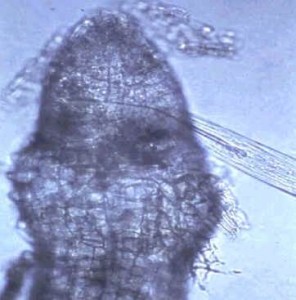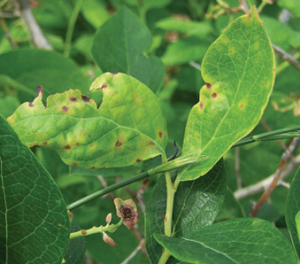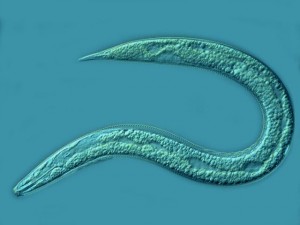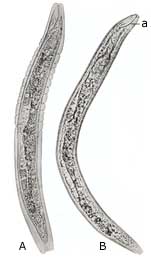Nematodes on Blueberries
Fred Warner, Diagnostic Services
Introduction
Cultivated blueberries are susceptible to plant-parasitic nematodes, microscopic roundworms that typically feed on or within the roots of plants. Plant-parasitic nematodes are all obligate parasites and need living host tissues to feed upon in order to grow and reproduce. The only method for detecting and diagnosing nematodes is the collection of soil and root samples for microscopic observation. All sound nematode management programs have strong sampling components.
Feeding by plant-parasitic nematodes on plant roots causes a reduction in root volume and mass. Small terminal galls can occur on roots. Highbush blueberries infected with damaging levels of plant-parasitic nematodes typically are stunted and slow-growing with smaller berries and lower yields. Feeding by nematodes does not result in any characteristic aboveground symptoms. Symptoms generally occur in patches, as nematodes are usually clumped in their distributions, and spread slowly.
Blueberries appear to withstand feeding by plant-parasitic nematodes fairly well. This statement is based on the low sample volume of nematode samples received by our lab. Highbush blueberries may be resistant to two of the most common plant-parasitic nematodes found in Michigan, the lesion nematode, Pratylenchus penetrans, and the northern root-knot nematode, Meloidogyne hapla. However, P. penetrans is commonly found associated with highbush blueberries in the Pacific Northwest. The nematodes that affect blueberries in Michigan are described below. Control options are extremely limited, particularly if nematodes reach damaging population densities, so problem avoidance is the key management strategy.
Dagger Nematodes

The American dagger nematode, Xiphinema americanum, is commonly encountered in Michigan as a pathogen of fruit crops including highbush blueberry. Feeding can result in the production of terminal galls on roots. However, dagger nematodes are primarily a concern because they are vectors of certain plant viruses that occur in blueberry, including tobacco ringspot (TRSV), the causal agent of necrotic ringspot, and tomato ringspot virus (ToRSV).


Sheath nematodes, Hemicycliophora spp., are infrequently detected in Michigan but are common on blueberry. Although they are one of the two most frequently detected types of plant-parasitic nematodes on highbush blueberry in our state, the yield loss they cause is undetermined.
Stubby-Root Nematodes

These nematodes, Paratrichodorus and Trichodorus spp., are also infrequently detected in Michigan and this includes highbush blueberry. They can significantly slow the growth of blueberry cuttings in propagation beds but typically do not cause conspicuous symptoms on older plants. They are potential virus vectors but none of the viruses transmitted by these nematodes is a problem in blueberry.
Other Nematodes
There are other types of nematodes that occur in highbush blueberry plantings including the stem nematode, Ditylenchus dipsaci. The stem nematode actually feeds within leaves and is typically only a problem on cuttings. As bushes get older, these nematodes have much more distance to traverse up stems to reach leaves, so their importance diminishes as the blueberry bushes mature.
Ring nematodes are also commonly found associated with blueberries. Not much is known about the extent of yield loss they cause in MI. Feeding by ring nematodes is believed to render plants more susceptible to winter injury.
Management
Avoidance of plant-parasitic nematodes is the primary management strategy and this is strongly emphasized. Blueberry planting sites should be sampled prior to establishment. This sampling is critical because there are no post-plant chemical options on blueberry, so control tactics must be implemented before the plants go into the ground.
Although highbush blueberries appear to tolerate feeding by nematodes fairly well and nematode problems are seemingly infrequently encountered (this is based on the low volume of samples received by Diagnostic Services for nematode analyses in blueberry plantings), site assessment of risk is still warranted. Dagger nematodes are of primary concern because of their abilities to vector viruses. When assessing blueberry planting sites, a few questions should be asked: 1) Have blueberries or any other fruit crops been grown here in the past? 2) Are broadleaf weeds, especially dandelion present (many broadleaf weeds are hosts to TRSV and ToRSV)? 3) Have viruses been detected on this site in the past?
If the answer to any of these questions is “yes,” it is imperative that soil and root samples are collected and analyzed for dagger nematodes. If dagger nematodes are recovered, their control is recommended. This can be achieved by soil fumigation, growing rapeseed cv. Dwarf Essex for 1 or 2 years, or by growing grasses for 2 years utilizing strict broadleaf weed control. Although grasses can host dagger nematodes, viruses are not passed onto their offspring as they must be acquired by feeding. Therefore, if broadleaf weeds are eliminated, the young nematodes cannot acquire viruses unless provided with infected plants. Always initiate plantings with virus-free planting material, especially if you’ve already incurred the time and expense of dagger nematode control.
In conclusion, nematode problems on blueberry in Michigan seem uncommon, except where dagger nematodes are involved in virus transmission. Sampling before planting is strongly advised for identifying potential future problem sites. Post-plant control options involve the destruction of infested plants and spot-treating of nematode populations. If bushes are tested for viruses and found to be positive, all roots should be removed from the soil prior to replanting. Be sure to replant with a variety that has tolerance or resistance to the virus(es) identified on the site (if this information is available).
If you have questions or concerns about nematodes on blueberries or any other crops, please call Angela Tenney at 517-353-8563. All nematode samples should be sent to Plant and Pest Diagnostics, 578 Wilson Rd., Room 117 Center for Integrated Plant Systems (CIPS), Michigan State University, East Lansing, Michigan 48824. Presently, the fee is $25.00 for nematode analysis.



 Print
Print Email
Email
